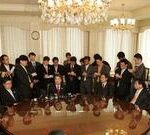Between March 1992 and November 1995, the Former Republic of Yugoslavia broke up violently in a devastating civil war, leading to the current nations of Bosnia, Serbia, and Croatia. In order to understand the nature of this conflict, it is important to know a few key terms.
Tudjman: An ardent nationalist, Franjo Tudjman was the president of Croatia from 1990 to his death in 1999. Tudjman, who is generally considered comparable to Slobodan Milosevic in terms of responsibility for the breakup of Yugoslavia and the war itself, supported Bosnian Croats throughout the war and allegedly met secretly with Slobodan Milosevic to discuss the division of Bosnia between Croatia and Serbia.
Kostunica: Although Vojislav Kostunica is currently the prime minister of Serbia, where he has recently raised international concern by jailing a prominent political opponent, his most important historical moment was when he beat Slobodan Milosevic in Yugoslavia’s 2000 presidential elections. When Milosevic refused to recognize the results of the poll, massive protests organized partially by the Otpor student movement forced him to step down on October 5.
Kosovo Polje: Also known as the Field of Blackbirds, Kosovo Polje was the site of the historic battle in 1389 in which the Serb army was crushed by the Turks. For that and other reasons, Serbs consider Kosovo Polje and Kosovo in general to have special significance to their culture, and have long resented the overwhelming Albanian majority there (a fact that Slobodan Milosevic capitalized on when he launched his political career from there by making a nationalistic speech to a large crowd in 1987).
Krajina: Before the war, Krajina (a region of Croatia that borders Bosnia) was mostly populated by Croatian Serbs. During the conflict, Croatian Serbs formed a quasi-independent (though unrecognized) state called the Republic of Serbian Krajina; however, in 1995, Croatian forces drove the vast majority of Croatian Serbs out of Krajina in a massive campaign of ethnic cleansing.
Mladic: Ratko Mladic, a Bosnian Serb, is currently wanted by the UN war crimes tribunal for genocide and other crimes against humanity, and is believed to be in hiding in Serbia (perhaps under the protection of prime minister Kostunica, who has opposed the extradition of Serbs to the UN tribunal). Mladic was the military commander of the Bosnian Serb army throughout the war, personally overseeing the campaign of ethnic cleansing and other atrocities, including the slaughter of thousands of Muslim men at Srebrenica.
UN Resolution 1244: On June 10, 1999, the UN Security Council passed UN Resolution 1244, which regulated the post-conflict situation in Kosovo. The resolution required the Federal Republic of Yugoslavia to remove its forces from Kosovo, established the presence of KFOR, and controversially left Kosovo’s final status undecided.
Chetnik: Originally, the term “Chetnik” referred to members of a Serbian nationalist movement that opposed Ottoman rule in the 19th century; however, the term was also used during WWII to denote a Serbian royalist movement that fought variously against the Nazis, the Croatian Ustasha, and the communist Partisans. In the 1990s, the Serbian “Chetnik,” along with the Croat “Ustasha” and Bosnian “Turk,” were used largely as propaganda tools (alluding to these past movements) by members of all sides to both inspire fear in and demonize their enemies.
SFOR: SFOR, meaning Stabilization Force, was the name for the NATO-led force in Bosnia that replaced IFOR (Implementation Force) in 1996; SFOR itself was subsequently replaced by EUFOR (European Union Force) in 2004. As its name suggests, SFOR was tasked with stabilizing the peace in Bosnia that had been implemented by IFOR according to the guidance of the Dayton Accords, and to do so on a more long-term basis.

